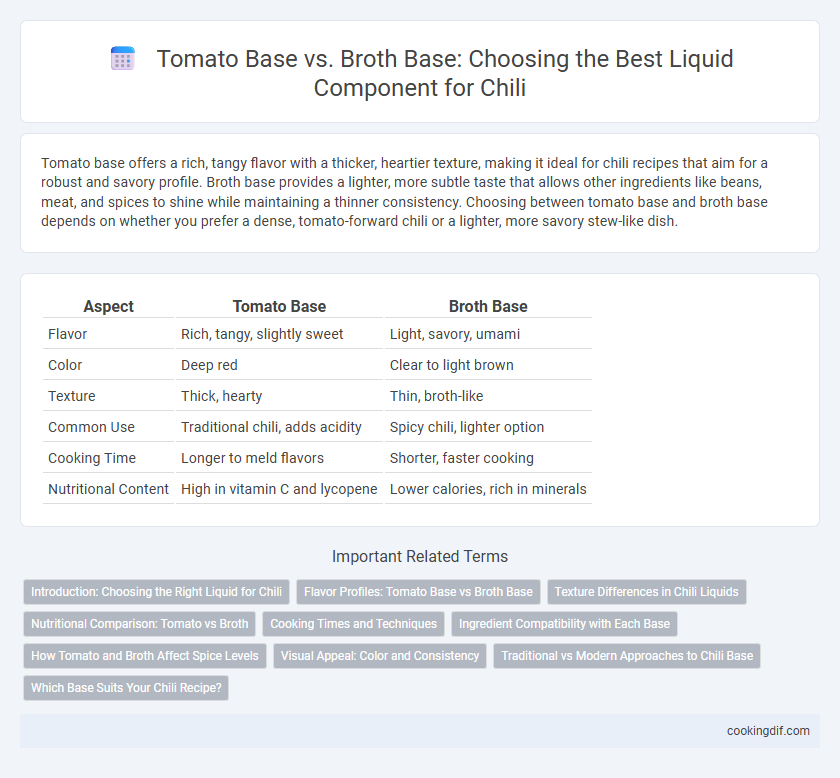Tomato base offers a rich, tangy flavor with a thicker, heartier texture, making it ideal for chili recipes that aim for a robust and savory profile. Broth base provides a lighter, more subtle taste that allows other ingredients like beans, meat, and spices to shine while maintaining a thinner consistency. Choosing between tomato base and broth base depends on whether you prefer a dense, tomato-forward chili or a lighter, more savory stew-like dish.
Table of Comparison
| Aspect | Tomato Base | Broth Base |
|---|---|---|
| Flavor | Rich, tangy, slightly sweet | Light, savory, umami |
| Color | Deep red | Clear to light brown |
| Texture | Thick, hearty | Thin, broth-like |
| Common Use | Traditional chili, adds acidity | Spicy chili, lighter option |
| Cooking Time | Longer to meld flavors | Shorter, faster cooking |
| Nutritional Content | High in vitamin C and lycopene | Lower calories, rich in minerals |
Introduction: Choosing the Right Liquid for Chili
Tomato base in chili provides a rich, tangy flavor and thick texture, enhancing the overall heartiness of the dish. Broth base offers a lighter, more savory profile, allowing spices and meat flavors to stand out while reducing acidity. Selecting between tomato base and broth base depends on desired richness and mouthfeel in chili recipes.
Flavor Profiles: Tomato Base vs Broth Base
Tomato base in chili provides a rich, tangy, and slightly sweet flavor with a vibrant red color that enhances the dish's depth and acidity. Broth base offers a more savory, umami-rich profile with a lighter, more subtle taste that allows the spices and meat flavors to stand out. Choosing between tomato or broth base significantly influences the chili's overall flavor balance, with tomato creating a robust, hearty experience and broth delivering a cleaner, more broth-forward taste.
Texture Differences in Chili Liquids
Tomato-based chili features a thick, rich texture that coats ingredients and provides a hearty mouthfeel, enhancing the overall density of the dish. Broth-based chili offers a lighter, more fluid consistency, allowing spices and flavors to blend subtly while maintaining a more soup-like quality. The choice between tomato and broth bases greatly influences the chili's texture, impacting its heartiness and the way flavors are perceived.
Nutritional Comparison: Tomato vs Broth
Tomato base in chili provides a rich source of vitamins A, C, and antioxidants like lycopene, which support immune health and reduce inflammation. Broth base, typically made from meat or vegetables, offers lower calories and sodium but contains essential minerals such as potassium and magnesium that aid hydration and muscle function. Choosing tomato base enhances fiber and antioxidant intake, while broth base contributes to hydration and electrolyte balance, making each option uniquely beneficial depending on dietary goals.
Cooking Times and Techniques
Tomato-based chili requires longer simmering times, typically 1.5 to 2 hours, to break down the acidity and develop a rich, thick sauce, while broth-based chili cooks faster, around 45 minutes to 1 hour, resulting in a lighter, soupier texture. Slow cooking tomato base enhances flavor complexity through caramelization and reduction, whereas broth base benefits from quicker sauteing of aromatics and controlled gentle simmering to preserve broth's delicate taste. Choosing between tomato or broth base impacts both cooking technique and final chili consistency, with tomato demanding patience for depth and broth offering speed and a cleaner finish.
Ingredient Compatibility with Each Base
Tomato base in chili enhances compatibility with ingredients like ground beef, beans, and spices such as cumin and chili powder, creating a rich, tangy flavor profile. Broth base pairs well with chunks of meat, vegetables, and grains, providing a lighter, savory foundation that allows fresh herbs and mild seasonings to stand out. Ingredient selection should align with the chosen base to balance acidity, richness, and seasoning intensity for optimal chili texture and taste.
How Tomato and Broth Affect Spice Levels
Tomato base in chili enhances the flavor profile by adding natural acidity and sweetness, which can mellow out the perceived heat of spices, creating a balanced and rich taste. Broth base, typically beef or chicken, provides a savory and umami foundation that intensifies the spice levels, allowing chili peppers and seasonings to stand out more prominently. Choosing between tomato and broth bases directly influences the spice perception, with tomato softening heat and broth amplifying it.
Visual Appeal: Color and Consistency
Tomato base in chili delivers a vibrant red color and thick consistency that enhances visual appeal and signals rich flavor depth. Broth base tends to yield a lighter, more translucent appearance with a thinner consistency, often suggesting a subtler taste profile. Choosing between the two influences not only color intensity but also the perceived heartiness of the chili.
Traditional vs Modern Approaches to Chili Base
Traditional chili recipes favor broth-based foundations, often using beef or chicken broth to enhance the savory depth and maintain a thinner consistency ideal for simmering robust spices and meats. Modern approaches increasingly incorporate tomato bases, introducing acidity and natural sweetness that balance the heat and provide a thicker, richer texture favored in contemporary chili variants. The choice between tomato base and broth base reflects evolving culinary trends, with tomato bases offering vibrant color and enhanced umami, while broth bases underscore authentic, slow-cooked flavor development.
Which Base Suits Your Chili Recipe?
Tomato base suits chili recipes that emphasize rich, tangy flavors and a thicker, heartier texture, often preferred in classic Tex-Mex or vegetarian chili. Broth base is ideal for lighter, spicier chili where a more savory, brothy consistency enhances the overall balance without overpowering other ingredients. Choosing between tomato and broth base depends on whether the recipe aims for bold, dense richness or a clearer, more subtle flavor profile.
Tomato Base vs Broth Base for liquid component Infographic

 cookingdif.com
cookingdif.com